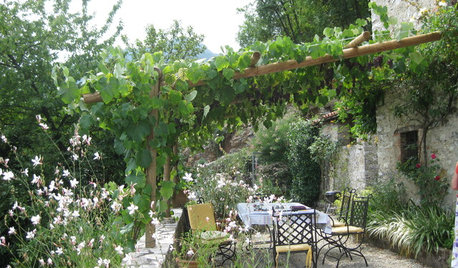For the Love of Ivy (Warning: Photo Heavy Thread)
catkim
12 years ago
Related Stories

DECORATING GUIDESWhat Goes With Dark Wood Floors?
Avoid a too-heavy look or losing your furniture in a sea of darkness with these ideas for decor pairings
Full Story
MATERIALSWoodipedia: Maple Is a Marvel Around the House
A heavy hardwood with lots of potential, maple appeals to modern sensibilities and won't break your budget
Full Story
LIFEHouzz Call: Show Us the House You Grew Up In
Share a photo and story about your childhood home. Does it influence your design tastes today?
Full Story
HOUZZ TOURSMy Houzz: Casual, Organic Elegance in California
Textural, nature-loving decor joins new floors and a more open kitchen for a relaxed vibe in a 1940s home
Full Story
EARTH DAYThe Case for Losing the Traditional Lawn
Work less, help the environment and foster connections by just saying no to typical turf
Full Story
HOUSEKEEPINGWhat's That Sound? 9 Home Noises and How to Fix Them
Bumps and thumps might be driving you crazy, but they also might mean big trouble. We give you the lowdown and which pro to call for help
Full Story
DIY PROJECTSHow to Replace a Button on a Tufted Chair
Fix a popped button on a tufted chair back with this upholstery teacher's step-by-step tutorial
Full Story
LANDSCAPE DESIGNRecipe for Mediterranean Edible Garden Style
The only thing better than a delicious meal outdoors is the satisfaction of growing some of the key ingredients yourself
Full Story
DINING ROOMS20 of the Coziest Dining Rooms on Houzz
Tantalizing fires, hearty wooden tables, cushy seats you want to linger in ... we toast these dining rooms with all that and more
Full Story
BATHROOM DESIGNBathroom Surfaces: Ceramic Tile Pros and Cons
Learn the facts on this popular material for bathroom walls and floors, including costs and maintenance needs, before you commit
Full Story








Yardvaark
whitecap2
Related Professionals
Holly Springs Landscape Architects & Landscape Designers · Manhattan Beach Landscape Architects & Landscape Designers · Westwood Landscape Contractors · Brockton Landscape Contractors · Kailua Landscape Contractors · Painesville Landscape Contractors · Pleasant Prairie Landscape Contractors · Ridgewood Landscape Contractors · Vineyard Landscape Contractors · Ankeny Decks, Patios & Outdoor Enclosures · Fort Worth Decks, Patios & Outdoor Enclosures · Haddonfield Decks, Patios & Outdoor Enclosures · Kansas City Decks, Patios & Outdoor Enclosures · Sugar Land Decks, Patios & Outdoor Enclosures · Redding Swimming Pool Builderskarinl
whitecap2
Yardvaark
whitecap2
Yardvaark
Yardvaark
whitecap2
Yardvaark
whitecap2
Yardvaark
whitecap2
tanowicki
whitecap2
Yardvaark
whitecap2
tanowicki
Yardvaark
whitecap2
Yardvaark
Yardvaark
catkimOriginal Author
karinl
bahia
duluthinbloomz4
adriennemb2
whitecap2
Yardvaark
karinl
bahia
whitecap2
drtygrl
karinl
whitecap2
Yardvaark
whitecap2
karinl
Yardvaark
karinl
whitecap2
timbu
whitecap2
adriennemb2
whitecap2
mothorchid
mothorchid
mothorchid
josephene_gw
Min3 South S.F. Bay CA